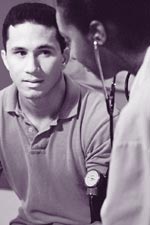Heads
Up: Preventing Brain Injuries
Brain injuries are caused by a bump or blow to the head. These injuries sometimes are called "concussions" or "traumatic brain injuries" (TBIs) and can range from mild to severe.
Most mild brain injuries cause no harm. But sometimes even mild brain injuries can cause serious, long-lasting problems. The best way to protect yourself and your family from brain injuries is to prevent them from happening in the first
place.
How to Prevent a Brain Injury
 Here are some tips from the Centers for Disease Control and Prevention (CDC) and the Brain Injury Association of America to reduce the chances that you or your family members will have a brain injury. Here are some tips from the Centers for Disease Control and Prevention (CDC) and the Brain Injury Association of America to reduce the chances that you or your family members will have a brain injury.
- Wear a seat belt every time you drive or ride in a motor vehicle.
- Always buckle your child into a child safety seat, booster seat, or seat belt (according to the child's height, weight, and age) in the car.
- Never drive while under the influence of alcohol or drugs.
- Wear a helmet and make sure your children wear helmets when:
- Riding a bike, motorcycle, snowmobile, or all-terrain vehicle;
- Playing a contact sport, such as football, ice hockey, or boxing;
- Using in-line skates or riding a skateboard;
- Batting and running bases in baseball or softball;
- Riding a horse; or
- Skiing or snowboarding.
- Avoid falls in the home by:
- Using a step stool with a grab bar to reach objects on high shelves;
- Installing handrails on stairways;
- Installing window guards to keep young children from falling out of open windows;
- Using safety gates at the top and bottom of stairs when young children are around;
- Removing tripping hazards such as small area rugs and loose electrical cords;
- Using non-slip mats in the bathtub and on shower floors;
- Putting grab bars next to the toilet and in the tub or shower;
- Maintaining a regular exercise program to improve strength, balance, and coordination; and
- Seeing an eye doctor regularly for a vision check to help lower the risk of falling.
- Make sure the surface on your child's playground is made of shock-absorbing material, such as hardwood, mulch,
and sand.
- Keep firearms stored unloaded in a locked cabinet or safe. Store bullets in a separate secured location.
When to Call the Doctor:
Signs and Symptoms of Brain Injury
|
When you visit the doctor, here are some important questions to ask:
- How long should I expect these symptoms to last?
- What should I do for this condition?
- Is it safe to get back to my normal daily routine, such as school, work, or playing sports and doing other physical activities?
- What can I do to keep from injuring myself again?
|
Here is a list of common symptoms of a brain injury (concussion). If you or a family member has a head injury and you notice any of the symptoms on the list, call your doctor right away. Describe the injury and symptoms, and ask if you should make an appointment to see your own doctor or another specialist.
Symptoms of a Concussion
In Adults
- Headaches or neck pain that won’t go away
- Trouble with such mental tasks as remembering, concentrating, or decision-making
- Slow thinking, speaking, acting, or reading
- Getting lost or easily confused
- Feeling tired all the time, having no energy or motivation
- Mood changes (feeling sad or angry for no reason)
- Changes in sleep patterns (sleeping a lot more or having a hard time sleeping)
- Feeling light-headed or dizzy, or losing balance
- An urge to vomit (nausea)
- Increased sensitivity to lights, sounds, or distractions
- Blurred vision or eyes that tire easily
- Loss of sense of smell or taste
- Ringing in the ears
In Children
- Feeling tired or listless
- Being irritable or cranky (will not stop crying or cannot be consoled)
- Changes in eating (will not eat or nurse)
- Changes in sleep patterns
- Changes in the way the child plays
- Changes in performance at school
- Lack of interest in favorite toys or activities
- Loss of new skills, such as toilet training
- Loss of balance, unsteady walking
- Vomiting
For More Information…
Brain Injury Association of America (BIAA)
BIAA has information about brain injury statistics and prevention as well as services for
persons who have a brain injury, and how to contact the Brain Injury Association in your state. Call BIAA toll-free at 1-800-444-6443, or visit BIAA on the Internet at
www.biausa.org.
Centers for Disease Control and Prevention (CDC)
CDC has a wide variety of information about prevention of mild traumatic brain injury and other types of injuries. Find CDC’s injury prevention resources at
www.cdc.gov/ncipc/.
National Bicycle Safety Network (NBSN)
The NBSN web site at www.cdc.gov/ncipc/bike/
has information about preventing brain
injuries through bicycle helmet use.
|
